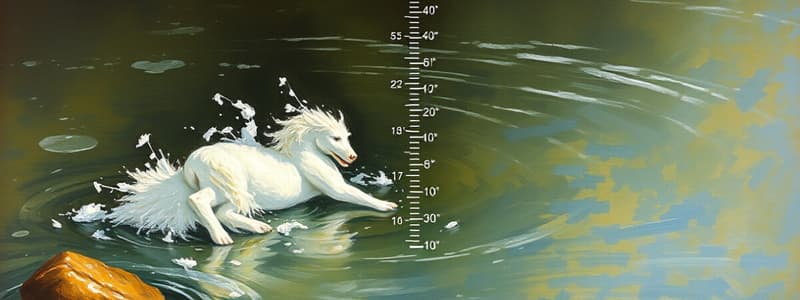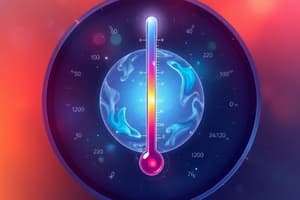Podcast
Questions and Answers
What is the equivalent temperature in Kelvin for 37°C?
What is the equivalent temperature in Kelvin for 37°C?
- 309 K
- 312 K
- 311 K
- 310 K (correct)
1°C corresponds to a change of 1 K.
1°C corresponds to a change of 1 K.
True (A)
Convert 39°C to Fahrenheit.
Convert 39°C to Fahrenheit.
102.2°F
To convert Celsius to Kelvin, you add __________.
To convert Celsius to Kelvin, you add __________.
Match the temperatures in Celsius with their equivalent in Kelvin:
Match the temperatures in Celsius with their equivalent in Kelvin:
Which of the following formulas is used to convert Fahrenheit to Celsius?
Which of the following formulas is used to convert Fahrenheit to Celsius?
To find body temperature in Fahrenheit, you multiply the Celsius value by 9/5.
To find body temperature in Fahrenheit, you multiply the Celsius value by 9/5.
What is the temperature range in Kelvin between 36°C and 37°C?
What is the temperature range in Kelvin between 36°C and 37°C?
Which of the following statements is true regarding physical and chemical changes?
Which of the following statements is true regarding physical and chemical changes?
Diagrams (b) and (c) represent physical changes.
Diagrams (b) and (c) represent physical changes.
What are the two types of numbers used in chemistry?
What are the two types of numbers used in chemistry?
An example of an exact number is __________ as it is defined.
An example of an exact number is __________ as it is defined.
Which diagram represents a physical change?
Which diagram represents a physical change?
Inexact numbers can only be derived from counting.
Inexact numbers can only be derived from counting.
Define significant figures in measurements.
Define significant figures in measurements.
Match the type of number to its definition:
Match the type of number to its definition:
How many significant figures are in the number 305?
How many significant figures are in the number 305?
Zeros located to the left of the first nonzero digit are considered significant figures.
Zeros located to the left of the first nonzero digit are considered significant figures.
What is one way to express a number that has ambiguous significant figures?
What is one way to express a number that has ambiguous significant figures?
The number 1.200 has __________ significant figures.
The number 1.200 has __________ significant figures.
Which of the following numbers has two significant figures?
Which of the following numbers has two significant figures?
The number 100 may have __________, __________, or __________ significant figures.
The number 100 may have __________, __________, or __________ significant figures.
Match the following descriptions with the correct number of significant figures:
Match the following descriptions with the correct number of significant figures:
When a number has a decimal point, any trailing zeros are considered significant.
When a number has a decimal point, any trailing zeros are considered significant.
What is the mass of the gas when the container is filled with it?
What is the mass of the gas when the container is filled with it?
The density of the gas is expressed in g/cm³.
The density of the gas is expressed in g/cm³.
What is the volume of the container in cm³?
What is the volume of the container in cm³?
Density is calculated using the formula: density = mass / __________.
Density is calculated using the formula: density = mass / __________.
Match the following values with what they represent:
Match the following values with what they represent:
What is the final density of the gas rounded to correct significant figures?
What is the final density of the gas rounded to correct significant figures?
The mass of the gas can be determined without any calculations.
The mass of the gas can be determined without any calculations.
What is the appropriate number of significant figures for the calculated density of the gas?
What is the appropriate number of significant figures for the calculated density of the gas?
What should you do if the leftmost digit to be dropped is equal to or greater than 5?
What should you do if the leftmost digit to be dropped is equal to or greater than 5?
Exact numbers have a limited number of significant figures.
Exact numbers have a limited number of significant figures.
What determines the number of significant figures in the result of a multiplication or division operation?
What determines the number of significant figures in the result of a multiplication or division operation?
In calculations with multiple steps, it is best to retain at least one extra digit until the end to minimize ______.
In calculations with multiple steps, it is best to retain at least one extra digit until the end to minimize ______.
Match the following operations with their outcome in terms of significant figures:
Match the following operations with their outcome in terms of significant figures:
What is the result of rounding 11.2154 to the correct number of significant figures if 1.4 has 2 significant figures?
What is the result of rounding 11.2154 to the correct number of significant figures if 1.4 has 2 significant figures?
Rounding errors can be avoided by rounding at each step of a multi-step calculation.
Rounding errors can be avoided by rounding at each step of a multi-step calculation.
When adding 317.5 mL and 0.675 mL, the result should be reported as ______ mL.
When adding 317.5 mL and 0.675 mL, the result should be reported as ______ mL.
Flashcards are hidden until you start studying
Study Notes
Temperature Conversion
- Normal human body temperature varies from approximately 36°C (morning) to 37°C (afternoon).
- Conversion to Kelvin:
- 36°C = 309 K
- 37°C = 310 K
- A 1°C change corresponds to a 1 K change.
Temperature Formulas
- Celsius to Fahrenheit:
[(°C × \frac{9°F}{5°C}) + 32°F] - Fahrenheit to Celsius:
[(°F - 32°F) × \frac{5°C}{9°F}]
Physical vs Chemical Changes
- Physical Changes: Identity of the substance remains unchanged.
- Chemical Changes: Identity of the substance changes post-reaction.
- Example: Certain diagrams may represent chemical changes (b & c) while others may depict physical changes (d).
Uncertainty in Measurements
- Measurement types:
- Exact numbers (defined values)
- Inexact numbers (derived from measurement).
- Significant figures reflect the precision of a measured value.
Significant Figures Rules
- Non-zero digits are always significant.
- Zeros between non-zero digits are significant.
- Leading zeros are not significant.
- Trailing zeros are significant only if there is a decimal point.
- Ambiguity in trailing zeros can be resolved using scientific notation.
Rounding Rules
- If the digit to be dropped is 5 or greater, round up.
- In calculations, retain one extra digit to minimize rounding errors.
Calculations with Significant Figures
- In multiplication/division, the result should reflect the least number of significant figures in the inputs.
- Exact numbers do not limit significant figures in results.
- For multi-step calculations, minimize rounding error by keeping more digits until the final result.
Example Problems
- Sample calculations involve adding, subtracting, multiplying, and dividing measured values while adhering to significant figure rules.
- The density calculation requires steps: First, determine mass, then divide by volume, applying significant figures rules.
Density Calculation Example
- Given a container mass of 124.6 g and a filled mass of 126.5 g:
- Mass of gas = 126.5 g - 124.6 g = 1.9 g
- Volume = 9.850 × 10² cm³
- Density = mass/volume = 1.9 g / 9.850 × 10² cm³ = 1.9 × 10⁻³ g/cm³.
Studying That Suits You
Use AI to generate personalized quizzes and flashcards to suit your learning preferences.



